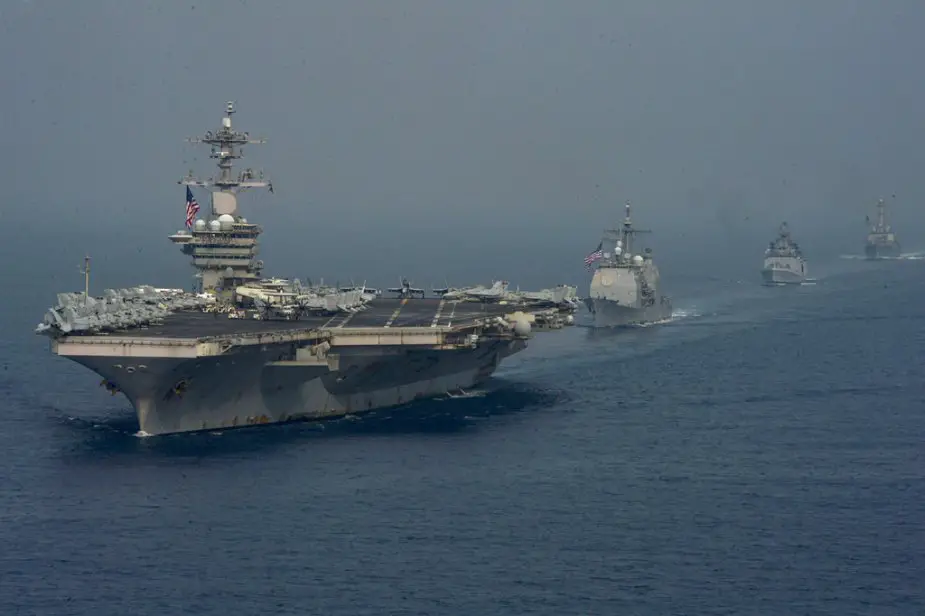Breaking news
USS Theodore Roosevelt conducts maritime exercise with INS Shivalik.
According to information published by US Navy on March 28, 2021, the Theodore Roosevelt Carrier Strike Group (TRCSG) conducted simultaneous joint multi-domain operations with the Indian Navy and Air Force in the Indian Ocean.
Follow Navy Recognition on Google News at this link
 USS Theodore Roosevelt (CVN 71), USS Bunker Hill (CG 52), INS Shivalik (F47) and USS Russell (DDG 59) sail in formation (Picture source: US Navy)
USS Theodore Roosevelt (CVN 71), USS Bunker Hill (CG 52), INS Shivalik (F47) and USS Russell (DDG 59) sail in formation (Picture source: US Navy)
Joint integration is key to elevate capability and capacity in the maritime domain. The highly successful exercise occurred on the heels of Secretary of Defense Austin’s scheduled visit to India.
The exercise focused on complex operations such as anti-submarine warfare, joint air operations, and command and control (C2) integration. It demonstrated the capacity of the two nations to operate together to advance a common vision of Indo-Pacific, ensuring peace and stability.
USS Bunker Hill (CG 52) and her embarked Maritime Strike Squadron (HSM 75), the “Wolf Pack”, USS Russell (DGG 59), and USS Theodore Roosevelt (CVN 71) operated with INS Shivalik (F 47) with embarked helicopter, Maritime Patrol Aircraft (P-8I) from INAS 312 – “The Albatross”, and Indian Air Force aircraft from Squadron No. 222 – “The Tigersharks”. U.S. and Indian forces exercised together seamlessly across all domains, demonstrating the compatibility of our platforms and operations on the sea and in the air.
The TRCSG is on a scheduled deployment to the U.S. 7th Fleet to help ensure freedom of the seas, build partnerships that foster maritime security, and to conduct a wide range of operations that support humanitarian efforts and act as deterrence to potential malign actions.
The TRCSG consists of USS Theodore Roosevelt (CVN 71), Carrier Air Wing (CVW) 11, the Ticonderoga-class guided-missile cruiser USS Bunker Hill (CG 52), Destroyer Squadron 23, and the Arleigh Burke-class guided-missile destroyers USS Russell (DDG 59) and USS John Finn (DDG 113).
Theodore Roosevelt’s embarked air wing consists of the “Tomcatters” of Strike Fighter Squadrons (VFA) 31, “Golden Warriors” of VFA-87, “Blue Diamonds” of VFA-146, “Black Knights” of VFA-154, “Liberty Bells” of Airborne Command and Control Squadron (VAW) 115, “Gray Wolves” of Electronic Attack Squadron (VAQ) 142, “Wolf Pack” of Helicopter Maritime Strike Squadron (HSM) 75, “Eightballers” of Helicopter Sea Combat Squadron (HSC) 8 and “Providers” of Fleet Logistic Support Squadron (VRC) 30 Detachment 3.
TRCSG’s operability in the region directly supports the Chief of Naval Operation’s navigation plan to master all-domain fleet operations, and exercise with like-minded navies to enhance our collective strength.
As the U.S. Navy's largest forward deployed fleet, U.S. 7th Fleet routinely operates between 50-70 ships and submarines and 140 aircraft with approximately 20,000 Sailors. 7th Fleet's area of operation spans more than 124 million square kilometers, stretching from the International Date Line to the India/Pakistan border; and from the Kuril Islands in the North to the Antarctic in the South Pacific, providing security and stability to the region. 7th Fleet interacts with 35 other maritime nations to build partnerships that foster maritime security while conducting a wide-range of missions to support humanitarian efforts and uphold international laws and freedoms of the sea.
Theodore Roosevelt departed San Diego for a scheduled deployment to the Indo-Pacific December 23.
INS Shivalik (F47) is the lead ship of her class of stealth multi-role frigates built for the Indian Navy.
The Shivalik-class frigates have a length of 142.5 m (468 ft) overall, a beam of 16.9 m (55 ft) and a draft of 4.5 m (15 ft). The ships displace about 4,900 tonnes (4,800 long tons; 5,400 short tons) at normal load and 6,200 tonnes (6,100 long tons; 6,800 short tons) at full load.[2] The complement is about 257, including 35 officers.[2]
They use two Pielstick 16 PA6 STC Diesel engines and two GE LM2500+ boost turbines in CODOG configuration providing a total of 47,370 shp (35,320 kW) of power. This allows the ships to reach a maximum speed of 32 knots (59 km/h; 37 mph).
The Shivalik-class frigates are equipped with a mix of Russian, Indian and Israeli weapon systems. These include the 76mm Otobreda naval gun, Klub and BrahMos supersonic anti-ship missiles, Shtil-1 anti-aircraft missiles, RBU-6000 anti-submarine rocket launchers and 6–324 mm ILAS 3 (2 triple)torpedoes. A 32 cell VLS launched Barak SAM and AK-630 act as Close-in weapon systems (CIWS). The ships also carry two HAL Dhruv or Sea King Mk. 42B helicopters


























